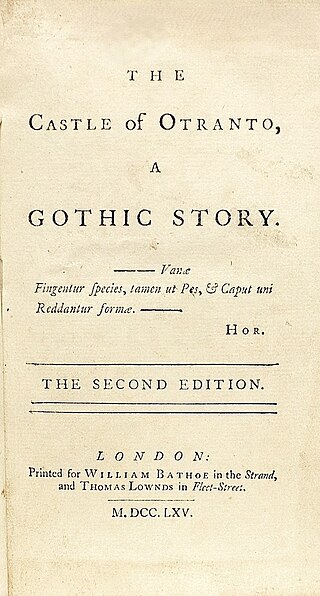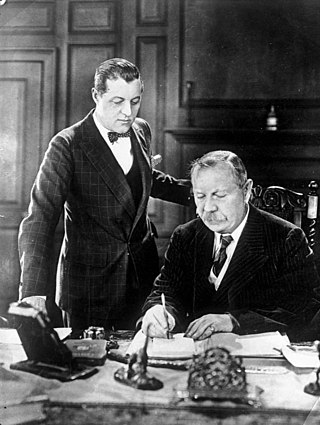
Gothic fiction, sometimes called Gothic horror, is a loose literary aesthetic of fear and haunting. The name refers to Gothic architecture of the European Middle Ages, which was characteristic of the settings of early Gothic novels.

Horror is a genre of speculative fiction that is intended to disturb, frighten, or scare. Horror is often divided into the sub-genres of psychological horror and supernatural horror, which are in the realm of speculative fiction. Literary historian J. A. Cuddon, in 1984, defined the horror story as "a piece of fiction in prose of variable length ... which shocks, or even frightens the reader, or perhaps induces a feeling of repulsion or loathing". Horror intends to create an eerie and frightening atmosphere for the reader. Often the central menace of a work of horror fiction can be interpreted as a metaphor for larger fears of a society.

Sword and sorcery (S&S) or heroic fantasy is a subgenre of fantasy characterized by sword-wielding heroes engaged in exciting and violent adventures. Elements of romance, magic, and the supernatural are also often present. Unlike works of high fantasy, the tales, though dramatic, focus on personal battles rather than world-endangering matters. The genre originated from the early-1930s works of Robert E. Howard. The term "sword and sorcery" was coined by Fritz Leiber in the 6 April 1961 issue of the fantasy fanzine Ancalagon, to describe Howard and the stories that were influenced by his works. In parallel with "sword and sorcery", the term "heroic fantasy" is used, although it is a more loosely defined genre.

Adrian Malcolm Conan Doyle was the youngest son of Sir Arthur Conan Doyle and his second wife Jean, Lady Doyle or Lady Conan Doyle. He had two siblings, sister Jean Conan Doyle and brother Denis, as well as two half-siblings, sister Mary and brother Kingsley.

George Edward Stanhope Molyneux Herbert, 5th Earl of Carnarvon,, styled Lord Porchester until 1890, was an English peer and aristocrat best known as the financial backer of the search for and excavation of Tutankhamun's tomb in the Valley of the Kings.
A mummy is an unusually well preserved corpse.

Tales from the Darkside: The Movie is a 1990 American comedy horror anthology film directed by John Harrison, serving as a spin-off of the anthology television series Tales from the Darkside. The film depicts the frame story of a kidnapped paperboy who tells three stories of horror to the suburban witch who is preparing to eat him.

The Jewel of Seven Stars is a horror novel by Irish writer Bram Stoker, first published by Heinemann in 1903. The story is a first-person narrative of a young man pulled into an archaeologist's plot to revive Queen Tera, an ancient Egyptian mummy. It explores common fin de siècle themes such as imperialism, the rise of the New Woman and feminism, and societal progress.

The Mummy, or Ramses the Damned is a 1989 horror novel by American writer Anne Rice. Taking place during the early twentieth century, it follows the collision between a British archeologist's family and a resurrected mummy.

The Great God Pan is an 1894 horror and fantasy novella by Welsh writer Arthur Machen. Machen was inspired to write The Great God Pan by his experiences at the ruins of a pagan temple in Wales. What would become the first chapter of the novella was published in the magazine The Whirlwind in 1890. Machen later extended The Great God Pan and it was published as a book alongside another story, "The Inmost Light", in 1894. The novella begins with an experiment to allow a woman named Mary to see the supernatural world. This is followed by an account of a series of mysterious happenings and deaths over many years surrounding a woman named Helen Vaughan. At the end, the heroes confront Helen and force her to kill herself. She undergoes a series of unearthly transformations before dying and she is revealed to be a supernatural entity.

The curse of the pharaohs or the mummy's curse is a curse alleged to be cast upon anyone who disturbs the mummy of an ancient Egyptian, especially a pharaoh. This curse, which does not differentiate between thieves and archaeologists, is claimed to cause bad luck, illness, or death. Since the mid-20th century, many authors and documentaries have argued that the curse is 'real' in the sense of having scientifically explicable causes such as bacteria, fungi or radiation. However, the modern origins of Egyptian mummy curse tales, their development primarily in European cultures, the shift from magic to science to explain curses, and their changing uses—from condemning disturbance of the dead to entertaining horror film audiences—suggest that Egyptian curses are primarily a cultural, not scientific, phenomenon.

Leslie S. Klinger is an American attorney and writer. He is a noted literary editor and annotator of classic genre fiction, including the Sherlock Holmes stories and the novels Dracula, Frankenstein, and Strange Case of Dr. Jekyll and Mr. Hyde as well as Neil Gaiman's The Sandman comics, Alan Moore's and Dave Gibbons's graphic novel Watchmen, the stories of H.P. Lovecraft, and Neil Gaiman's American Gods.

"Some Words with a Mummy" is a satirical short story by American writer Edgar Allan Poe. It was first published in The American Review: A Whig Journal of Politics, Literature, Art and Science in April 1845. It is an important early portrayal of a revived Egyptian mummy.
Marty Ross is a Scottish writer, best known for his audio dramas for the British Broadcasting Corporation, Big Finish Productions and for the Wireless Theatre Company and 3Dhorrorfi. He is author of the 'Tartan Noir' thriller novel Aztec Love Song. He has had several plays performed on stage, mostly with an emphasis on Gothic horror and the surreal. He has dramatized stories by other Scottish writers such as James Hogg, Robert Louis Stevenson, and Sir Arthur Conan Doyle in his radio series The Darker Side of the Border. Among his influences are the work of Hammer Films and British science fiction dramatist Nigel Kneale.

The Narrative of John Smith (2011) is a novel written in 1883 by Arthur Conan Doyle, published posthumously by The British Library. In a work of narrative fiction, Doyle writes from the perspective of a middle-aged bachelor named John Smith recovering from rheumatic gout. Unlike his later work in detective fiction, fantasy, and science fiction, this novel unfolds through a series of tangential, essay-like thoughts stemming from observations on everyday life. The subjects are of a “personal-social-political complexion”.
Roger Luckhurst is a British writer and academic and since 2020 the Geoffrey Tillotson Chair of Nineteenth Century Studies at Birkbeck College. He was appointed professor in modern and contemporary literature in the Department of English, Theatre, and Creative Writing at Birkbeck, University of London in 2008 and was distinguished visiting professor at Columbia University in 2016. He works on Victorian literature, contemporary literature, Gothic and weird fiction, trauma studies, and speculative/science fiction. Luckhurst is notable for his introductions and editorships to the Oxford World's Classics series volumes -- Late Victorian Gothic Tales,Dracula, Strange Case of Dr Jekyll and Mr Hyde, The Portrait of a Lady, H.P. Lovecraft's Classic Horror Tales, King Solomon’s Mines, and The Time Machine -- and for his books on J. G. Ballard (1997), The Invention of Telepathy (2002), Science Fiction (2005) The Trauma Question (2008), The Mummy’s Curse: The True Story of a Dark Fantasy, and Zombies: A Cultural History. He has also written two books for the British Film Institute classic film series on The Shining and Alien.

Mummies are commonly featured in horror genres as undead creatures wrapped in bandages. Similar undead include skeletons and zombies.
Henrietta Dorothy Everett, who wrote under the pen name Theo Douglas, was a British novelist who was popular during her lifetime but who is now largely forgotten. Her identity was revealed in 1910 but little is known of her life.

Eric J. Guignard is an American horror, dark fantasy, and literary fiction anthologist, editor, and author. He is a lifelong resident of Southern California, and teaches Technical Writing through the University of California system.
Lot No. 249 is a short film which is part of the British supernatural anthology series A Ghost Story for Christmas. Produced by Isibeal Ballance and written and directed by Mark Gatiss, it is based on the gothic horror story of the same name by Arthur Conan Doyle, first published in Harper's Magazine in 1892, and first aired on BBC Two on 24 December 2023.


















